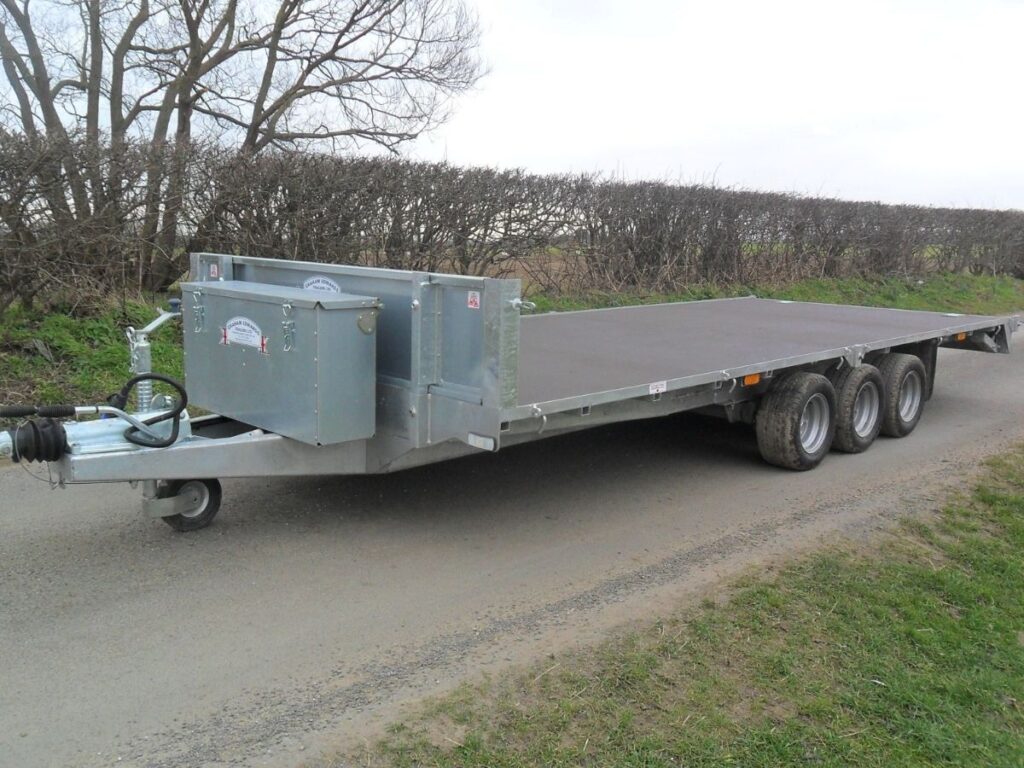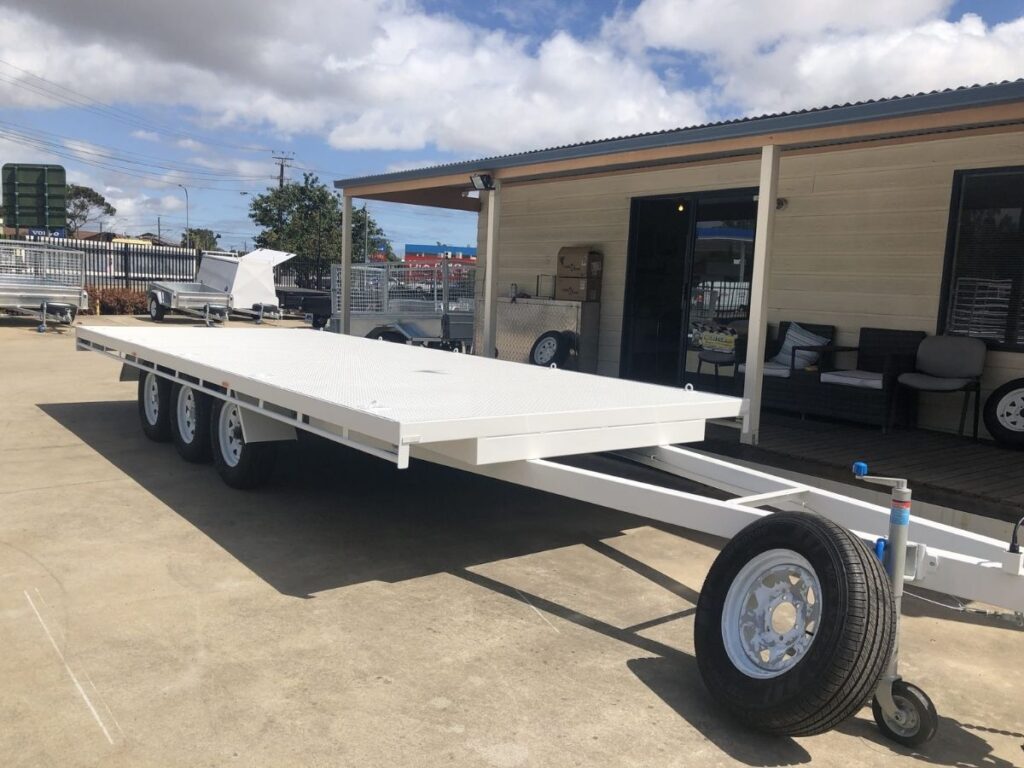I learned the hard way that not every trailer can handle the loads we deal with.
We had just taken on a job moving compactors. One run in, and the suspension was already wearing down. The trailer just wasn’t built for it.
That’s when I started digging into tri axle trailers.
Over the years, I’ve worked closely with trailers—choosing, testing, hauling. I’ve made mistakes and learned from them. That’s why you can trust what you’ll find here.
In this article, I’ll walk you through the 6 biggest benefits of using a tri axle trailer. You’ll see what makes them different and why they matter.
By the end, you’ll have what you need to decide if this setup fits your hauling needs—or not.
So let’s get started!
1. Higher Payload Capacity for Heavier Loads
Back when I was using a tandem axle trailer, I always felt limited. One job, we had to haul a compact excavator. Nothing massive—but it pushed us right to the weight limit. We had to strip down attachments just to make it work.
Once I switched to a tri axle trailer, that changed. No more juggling what to load. No more guessing if we were cutting it too close. We had space—and weight room—to work with.
Why It Matters
With a tri axle trailer, you can carry more weight legally.
That means fewer trips. Less fuel. And more done in less time.
Here’s why it matters to you:
- Construction crews can move heavier machines like bulldozers, graders, and excavators in one go.
- Mining operations can haul dense loads like coal, stone, or ore without overloading.
- Manufacturing and logistics teams can load more bulk goods or equipment—especially on long routes.
This helps you work faster without breaking weight rules.
Key Benefits
- More Axles = More Capacity: The extra axle spreads out the load. This raises your Gross Vehicle Weight Rating (GVWR)—that’s the total legal weight your trailer can handle.
- Stay Legal, Stay Safe: Tri axles help you stay under legal road limits. That cuts your chances of overloading fines, inspections, or having to offload at checkpoints.
- Protect Roads and Equipment: By sharing the weight across more axles, you reduce stress on roads—and on your trailer’s parts. That means fewer breakdowns and repairs.
- Payload Range: Depending on the trailer type and local laws, tri axle trailers can carry up to 70–75 tons. Tandems often max out around 40–50 tons (source).

2. Better Weight Distribution and Stability
I’ll never forget the time we hit a stretch of bumpy gravel with a heavy machine loaded on a tandem axle trailer.
Even though the load was within legal weight, it didn’t ride right. The back end kept swaying. Braking felt delayed. On turns, the trailer would lean too much. It was stressful—and it felt unsafe.
That trip made me look into tri axle trailers more seriously. What I learned made total sense.
Why It’s a Game-Changer
When you add more axles, the weight gets spread out across more wheels.
That means:
- Less stress on any single point
- Better traction
- And more stable handling—especially at highway speeds or off-road
This matters most when you’re carrying uneven loads or working in tough terrain. With three axles, the trailer sits more balanced on the road, even when hauling heavy machinery or bulk cargo.
You’ll also notice:
- Less trailer sway in wind or sharp curves
- Smoother braking
- More grip on loose or muddy surfaces
It doesn’t just feel better. It drives better. And that makes every haul safer.
Ideal For
Tri axle trailers offer better stability in places like:
- Off-road worksites, such as construction zones, quarries, or remote energy fields
- Rural areas with rough or unpaved roads, common in farming regions
- Long highway routes, where better control at high speeds matters
If your job takes you into any of these environments, you’ll feel the difference right away.
What Can Go Wrong Without It?
Poor weight distribution can cause real problems:
- Increased tire wear, especially on the rear axle
- Higher fuel use, because your truck works harder to keep things steady
- Brake strain, which can shorten lifespan and reduce stopping power
- Load shift, making the trailer harder to control
I’ve seen trailers skid on gravel, bounce over potholes, and even drag underpowered axles—all because the weight wasn’t spread evenly.

3. Improved Road Compliance and Legal Advantages
I remember pulling into a weigh station after hours on the highway.
The tires were hot. The cab smelled like dust and diesel. I was tired—but confident. Why? Because I had a tri axle trailer under me.
That trailer helped me stay under the legal weight limit, even with a full load of equipment.
No fines. No offloading. Just a green light and the road ahead.
Stay Within Axle Load Limits
Every region has its own axle weight laws. What’s allowed in one state might get flagged in the next. That makes long-haul jobs tricky—especially if you’re right at the edge of your limit.
Tri axle trailers help you stay within legal weight limits by spreading the load across three axles instead of two.
That means:
- You carry more weight legally
- You avoid expensive fines and surprise inspections
- You’re less likely to get stopped and forced to reload at a weigh station
It’s not just about following the rules. It’s about keeping your trip smooth and stress-free.
Who This Helps
This benefit is huge if your work crosses borders or covers long routes.
Tri axle trailers make life easier for:
- Logistics companies moving cargo across provinces or states
- Retail distributors making deliveries across regions
- Energy and mining operators hauling from remote sites into towns or ports
If you’ve got distance to cover and rules to follow, a tri axle trailer gives you the space to do both.

4. Greater Durability Under Harsh Working Conditions
If you’ve ever pulled a loaded trailer through a muddy jobsite or down a gravel access road, you know how rough that can be.
Potholes. Sharp turns. Uneven ground. It all adds up fast.
I’ve seen trailers break welds, blow tires, or wear out suspensions long before their time—all because the setup wasn’t made for the work. That’s one of the reasons I turned to tri axle trailers.
Built for Rough Roads and Heavy Work
The third axle might not look like much, but it does a lot.
It spreads out the weight better, so less stress is put on the suspension, tires, and brakes. That means fewer breakdowns. And a longer life for your trailer.
When you’re running in hard environments, that kind of support matters.
Here’s how a tri axle setup helps:
- Reduces strain on each axle and wheel
- Improves braking power, especially on steep or slippery roads
- Protects tires from uneven wear
- Lowers stress on the trailer frame and body
I’ve noticed this most when hauling on unpaved or uneven routes. The trailer handles the bounce better. And I spend less time (and money) on maintenance.
Critical for Industries Like
If your work involves rough terrain or heavy hauling, you’ll benefit the most.
That includes:
- Mining, where raw materials like coal or stone are moved over gravel and dirt roads
- Construction, where you’re hauling machines and bulk material across uneven jobsites
The more rugged the route, the more the extra axle helps.
Built to Last
Most tri axle trailers use high-strength steel, reinforced frames, and heavy-duty suspensions. These parts are built to take hits—from potholes, bumps, and long-term use.
This isn’t just about toughness. It’s about value.
A trailer that lasts longer saves you money in the long run. Fewer repairs. Less downtime. Better performance.
5. Cost Efficiency Over the Long Run
When I first saw the price of a tri axle trailer, I thought it was too much. But after using it for a few months, the savings started to show. Fewer trips and lower fuel bills made a real difference. It didn’t take long before the trailer started paying for itself.
Save More Per Trip
With a higher payload, you move more in one trip instead of making two. That means less time on the road and less fuel burned. You also cut down on driver hours, which saves even more. For busy routes, that kind of efficiency matters.
Supporting Points
Tri axle trailers cost more upfront than tandems, but they save money in the long run. They don’t wear out as fast, and you spend less on tires and repairs. Load stress is shared across more axles, so parts last longer. If you haul daily, the return shows up quickly.
Think Long-Term
If you look past the starting cost, the long-term value becomes clear. A tri axle trailer cuts down on fuel, labor, and maintenance. You’ll notice fewer breakdowns and less downtime. That’s why I kept mine—and I’d make the same choice again.

6. Versatile for Multiple Trailer Types
When I first heard about tri axle trailers, I figured they were just for flatbeds. One type, one use. But I quickly realized that this axle setup works across many trailer styles—and that opened up a lot more options for my work.
I remember thinking to myself, If I can use this setup for different jobs, I won’t need a whole fleet of trailers. That’s when the value really hit me.
One Axle Setup, Many Uses
Tri axle trailers are used across several trailer types:
- Flatbeds: Ideal for equipment, steel, pallets, or bulk materials. I once loaded up pallets of bricks in the morning, then hauled a skid steer later that afternoon—on the same trailer.
- Dump trailers: Perfect for sand, gravel, or construction waste. The third axle helps handle shifting weight without wearing out your suspension.
- Low-bed trailers: Built for machines like dozers, rollers, or excavators. I’ve hauled heavy equipment without the usual worries about balance or tipping.
- Tanker trailers: Used for fuel, water, and other liquids. A tri axle setup keeps the ride smoother and more stable, especially over long routes.
Helps These Sectors
If you work in any of the following industries, this flexibility matters:
- Construction: For dump or low-bed trailers used on tough jobsites.
- Oil & Gas: For tanker trailers hauling fuel or liquid materials.
- Independent Haulers: You get more job variety without needing multiple trailers.
It’s one of those upgrades that quietly gives you more control. You don’t always notice it at first, but it keeps paying off.
Conclusion
We’ve covered it all—payload, balance, legal benefits, durability, and cost savings.
But here’s what it comes down to: tri axle trailers give you more freedom to do your job with less hassle.
I’ve made that shift. And it changed how I plan every haul.
You’ve got the knowledge now. The rest is up to you.
Are you ready to upgrade your trailer and your peace of mind?
Contact us today and let’s talk about what fits your needs.


